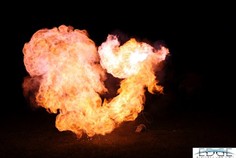Pick a Lift Gas ($120 - $800)
If it seems like that's a big price spread, you're right. The biggest deciding factor here is what lift gas you use: helium or hydrogen (the two most common lift gasses).
Helium is inert, easy to deal with, and doesn't generally raise any questions about the Hindenburg. It's also very expensive, if you can get your hands on it at all. Over the past several years, the US Gov. has been selling off its strategic reserve of helium, which has led to artificially depressed prices and easy availability. It may still be possible to get from some welding supply shops, but it will generally be of unknown purity, so it won't have guaranteed lift characteristics - and it will still be expensive.
Hydrogen is flammable (as seen in the ignition test of a 3' diameter balloon above) and therefore requires more care when inflating. If you're planning on launching with an organization or in a public place, it will probably raise some eyebrows when it's mentioned as an option. It's also far less expensive, and what we use exclusively due to Helium's availability problems. We secured 240 cu. ft. of H2 for just over $120 recently. Handled correctly (with respect), it's not a problem: make sure that there's as little air as possible in the balloon prior to inflation, seal the neck during inflation, and don't allow smoking or spark sources near the balloon, for example.



